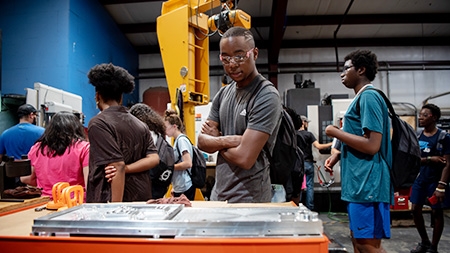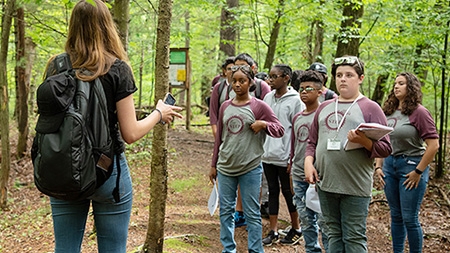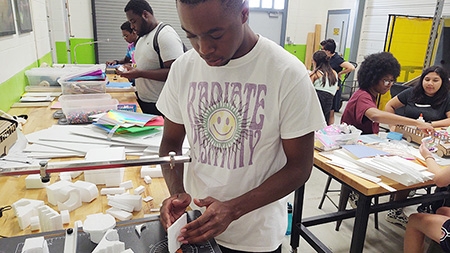For Kevin Trigonis, this pretty much sums it up – the reason so many people get in on STEP. Alums, faculty, staff and students. They all want to make a difference for local secondary school students.
Like Kira Streichert of Schenectady. Now a member of the Class of 2026, she spent her senior year of high school participating in everything STEP had to offer.
“Being in STEP at Union was one of the best things I have ever done,” she said. “I discovered so many different things about myself and my community, and I was able to find new ways to challenge myself socially and intellectually.”
Since 1994, Union has received a Science and Technology Entry Program (STEP) grant from New York State to prepare historically underrepresented and economically disadvantaged students to enter college. STEP also seeks to increase participation in math, science, technology, health-related fields and licensed professions.
The benefits aren’t one-sided, either. STEP volunteers get just as much out of the program as the participants. But more on this later.
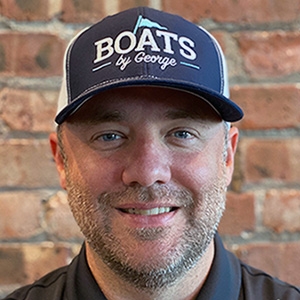
Step in classroom & field
This year, STEP is providing services to 77 middle and high school students from 13 area districts, said Trigonis, who directs the program at Union. Students benefit from SAT/ACT preparation, STEM and healthcare professions workshops, field trips to local businesses and visits to area colleges, and research opportunities.
For instance, this summer, STEP students visited Dynamic Energy to learn about its solar energy business. They also toured Schenectady-based P1 Ventures.
“We’re an engineering and manufacturing company that works with some of the largest corporations – like GE – in the world,” explained founder and CEO David Dussault ’00. “We partner with these companies to help them engineer and manufacture their products, and optimize design and delivery. We want to revitalize American manufacturing – open up U.S. factories and put people back to work in meaningful manufacturing careers. We want to export instead of import.”
STEP students saw this mission in action when they visited P1. The experience made an impression.
“Most of them said, ‘Wow, we never knew that things were made in Schenectady for such important infrastructure around the world,’” Dussault recalled. “P1 is making technology for submarines, the U.S. military, space exploration and the energy sector.”
“The students liked understanding the big picture of what we’re making here and what we’re making it for, and then actually seeing these things being physically made right in Schenectady,” he continued. “We want to hire and inspire the next generation; these opportunities with STEP are an important part of that.”
STEP students also took trips to the Glenville Aeroscience Museum, SUNY Polytechnic Institute, Albany Nanotech Complex, and Union’s Kelly Adirondack Center. There they participated in an environmental science day, led by Maeve Daby ’23.
They spent a lot of time on Union’s campus, too.
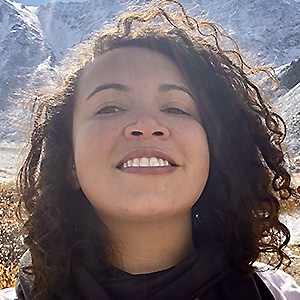
STEP in college
STEP students (grades 10-12) participated in a workshop led by Makerspace Director Cole Belmont and Associate Professor of Biology Nicole Theodosiou. The curriculum was based on a project developed by Theodosiou – the creation of a mobile “tiny house” that would take science and technology out into the local community to engage and educate Schenectady residents.
“Students worked in teams to create their own tiny houses,” Belmont said. “They worked in the library for research, got hands-on experience in our Makerspaces to create physical prototypes and worked in our computer labs to detail digital models and presentations. Ultimately, the STEP teams gave public presentations of their projects in Reamer Auditorium.”
Faculty involvement in STEP extends beyond experiential learning as well. Professors Deidre Hill Butler (sociology), Kathleen LoGiudice (biology), Cheikh Ndiaye (French and francophone studies), Cherrice Traver (computer engineering), Mary O’Keefe (economics), and Ashok Ramasubramanian (mechanical engineering) are members of the STEP Advisory Committee.
Throughout the school year, Union students also act as mentors and tutors.
Last year, Trigonis said, 46 Union students volunteered their time in this capacity. One of them was Ebyan Abshir ’24, an Africana Studies major, who provided Spanish and math tutoring.
Every week in fall 2021, she created lesson plans for, and held virtual meetings with, two middle school students.
“I was happy to make every tutoring session revolve around the students’ needs and what they wanted to focus on,” Abshir said. “Going into winter and spring term, I became more involved in STEP and started volunteering at the middle schools as a tutor. I helped students work on math and prepare fun and safe science experiments.”
And she’s loved every second of it.
“When I learned about STEP, I was happy to start working as a mentor and create a family among students, faculty and tutors,” Abshir said. “What makes STEP an exciting and gratifying experience is being a role model for younger students and providing them with the extra support they need in their classes and education.”
She’s also learned a lot that will help her on her own journey.
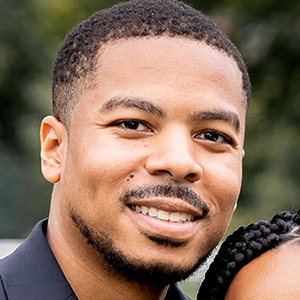
Everyone wins
“STEP made me gain a new understanding of responsibility as a college student,” Abshir said. “I’ve learned to maintain a level of commitment to all of my activities that I’m proud of. And being a role model for younger students pushes me to organize my priorities and helps me grow my own abilities.”
“STEP has also reinforced my desire to make a difference, either in policies related to healthcare or in practice as a physician or physician assistant, providing quality, accessible care.”
Maya Whalen-Kipp ’16 can relate.
She first became a STEP mentor in 2013 and has led a number of STEP workshops on environmental science, graphic design and chemistry over the years. At Union, she studied biology and visual arts. Today, she’s an ORISE Science Technology & Policy Fellow at the U.S. Department of Energy, where she works on marine renewables.
“STEP trains you to think of your feet and be creative. STEP also teaches you that there is always a way to make an impact, even it’s just helping a student send emails to the college they’re applying to,” said Whalen-Kipp. “Show up with good intentions, everything else will work out.”
Whalen-Kipp, who participated in similar programs as a teen, also places immense value on what the STEP students learn.
“These programs enable underrepresented students to be exposed to creative thought and leaders in STEM and art fields. They provide space for us to think outside the box, envisioning a future for ourselves that maybe we’ve never thought of before,” she said.
Elroy Tatem ’06 echoed these thoughts.
An electrical engineering major who is now an instructor in the semiconductor industry, Tatem was also a STEP mentor during his Union days. As an alum, he has continued to facilitate workshops in science and engineering.
Of his favorite part of working with STEP students he said, “You can give them a vision of what is possible and watch them internalize it. They not only achieve those things, but go on to lead lives even greater than the vision you showed them.”
This kind of outcome is what motivated Dussault to collaborate with STEP.
“To continue to revitalize American manufacturing, and hire and inspire the next generation, we need to find those in our local community who can help us do that,” he said. “We want to develop, train and recruit folks, and we like the idea of helping those who are underrepresented in STEM and manufacturing jobs.”
“I grew up pretty low on the socioeconomic ladder, so I like finding people who might have the ability but not the opportunity,” Dussault continued. “I love giving people from our community the chance to thrive.”
And when the community thrives, so does P1.
“The partnerships STEP creates are critical. Often, as a business owner, developing employees from the ground up is something you kind of have to do alone,” Dussault said. “So to have a state grant program paired with a world-class school like Union – that’s collaborating with a business like ours – is a really powerful combination.”
“In fact, we’re going to start internships for STEP students at P1,” he added. “Kevin Trigonis will help us find promising candidates and then over the next year, we’ll be engaging them in internships, which could lead to various career paths for them or hiring with P1.”
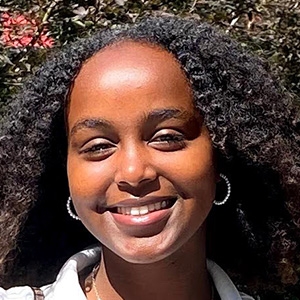
STEP student success
Success comes in many forms for STEP students, whether its internships, college or something else.
For Kira Streichert ’26, it was college. At Union.
Her STEP experience showed her there’s no place she’d rather be.
During workshops on campus, “I made lasting connections with Union staff and I got along with Kevin Trigonis right away,” Streichert said. “He even helped with my college decision, sitting down and discussing pros and cons in an unbiased way. I felt that there was genuine support at Union, which is something that’s very valuable to me and motivated me to choose Union.”
STEP also motivated her to strive for more. Meeting astronaut Nicole Stott was particularly inspiring.
“This was probably my favorite experience in the program. I got to meet Nicole and ask her questions. My dream was to become an astronaut when I was younger, so it was just unforgettable,” Streichert said.
The fact that Stott majored in aeronautical engineering didn’t hurt, either. The field, as well as space travel, are mostly male dominated.
“It was encouraging to meet her as I begin my journey in college,” Streichert said. “I hope to become an engineer.”
“My path in STEP has taken me full-circle, as I am now a STEP mentor myself,” she added. “I hope to be an example for the kids in STEP to follow their passions and encourage girls to take an interest in engineering.”
Malachi Burnham is also pursuing a degree. He graduated from Schenectady High School in June and is now attending SUNY Schenectady Community College.
“I am planning on becoming a physician assistant in an underserved area to give back to the community,” he said. “STEP helped me decide on the college that best suited me and helped prepare me for PA school.”
Emily Aldas, a senior at Niskayuna High School, is looking forward to the future, too. Most interested in chemical or electrical engineering right now, she wants to pursue a STEM-related major in college.
“STEP has really helped me realize how much I love math and engineering,” she said. “My favorite thing is the research projects. They’re so much fun and real hands-on experiences I learned a lot from.”
Angela Commito isn’t surprised to hear how much Streichert, Aldas and Burnham loved their hands-on STEP experiences.
In the workshop she led last year with Belmont, students did 3D modeling in archaeology. They handled real artifacts, did mini excavations, explored scientific methods, and designed and printed their own 3D models of artifacts.
“It’s essential to be in these spaces physically if you’re a young person interested in research, not just in STEM fields but also in arts and humanities,” said Commito, senior lecturer in classical archaeology. “Getting comfortable in these spaces – seeing yourself in these spaces – is an essential step for anyone interested in research or a career in science, technology and other fields.”
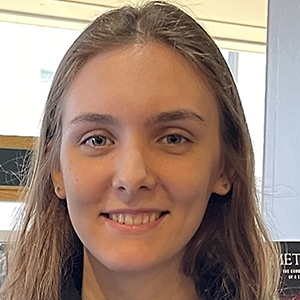
What STEP means to Union
Bringing these teens to campus is also invaluable for Union.
“These students are incredibly talented and motivated, and the community at Union would benefit enormously if they ended up attending the College,” Commito said. “Even if that doesn’t always happen, having the students on campus helps make Union an outward-facing community engaged with the broader public, which is an important role for an institution of higher education.”
“Every college or university is located in a specific place, and the people, history and resources of Schenectady cannot be found anywhere else,” she continued. “By integrating those into campus as much as possible – especially in the form of face-to-face interaction and collaboration – Union becomes a truly unique community. One that cannot be found anywhere else.”

